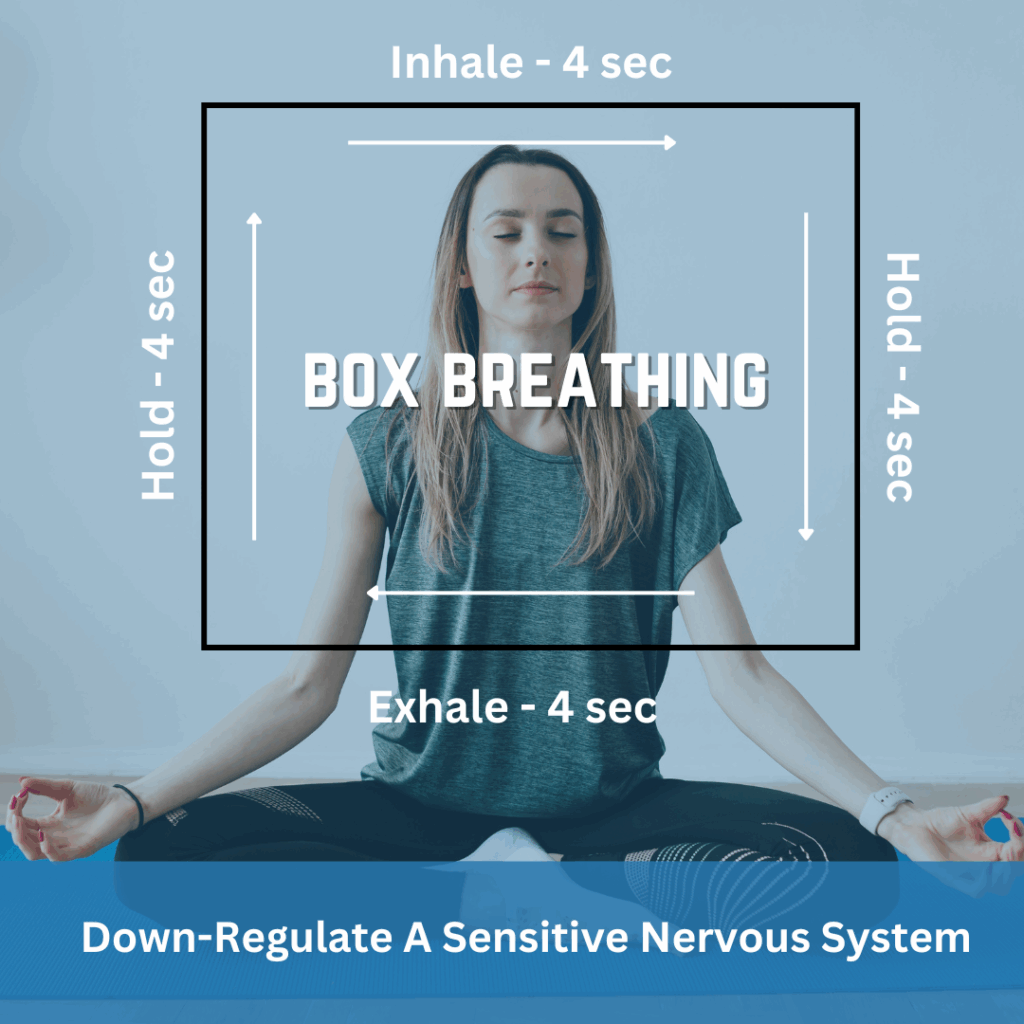When it comes to pain management, most people think of medications, stretching, or physical therapy. But one of the most overlooked — and powerful — tools is something you do all day, every day: breathing. Specifically, how you breathe can profoundly impact your nervous system, and by extension, your pain levels.
Box breathing, a technique used by Navy SEALs, athletes, and health professionals, offers a simple and effective way to regulate your nervous system, reduce stress, and manage chronic pain. This blog post will explore how box breathing works, why it matters for people with sensitive or dysregulated nervous systems, and how to start using it to support your own recovery journey.
Understanding the Nervous System and Pain
Your nervous system has two primary branches:
- Sympathetic (fight or flight)
- Parasympathetic (rest and digest)
When you’re under stress — whether from trauma, poor sleep, chronic illness, or pain — your sympathetic system dominates, keeping you in a heightened state of alert. While this system is crucial for short-term survival, chronic activation can lead to increased pain sensitivity, poor recovery, disrupted sleep, and anxiety.
This state is often called central sensitization — where the nervous system becomes hypersensitive and overreacts to normal signals. People in this state may feel:
- Pain from light touch or normal movement
- Constant tightness or muscle guarding
- Fatigue, brain fog, and poor focus
- A cycle of tension and discomfort that seems hard to break
This is where box breathing comes in.
What Is Box Breathing?
Box breathing (also called square breathing) is a structured breathing technique that helps regulate the autonomic nervous system. The method is simple:
- Inhale for 4 seconds
- Hold for 4 seconds
- Exhale for 4 seconds
- Hold for 4 seconds
Repeat this cycle for several minutes.
It’s called “box” breathing because each phase is equal in length, like the four sides of a box. The goal is to create rhythm, control, and balance in your breath — which signals safety to your brain.
The Science Behind Box Breathing
Box breathing works by stimulating the vagus nerve, which plays a key role in activating your parasympathetic (rest and digest) nervous system. When you extend your exhales and hold your breath in a controlled manner, you’re essentially telling your brain, “We’re safe now. You can relax.”
This has a cascade of positive effects:
- Lowers heart rate and blood pressure
- Reduces cortisol and stress hormones
- Improves oxygen delivery and tissue recovery
- Enhances pain tolerance and emotional regulation
In people with chronic pain, especially those dealing with conditions like fibromyalgia, tension headaches, or nonspecific low back pain, the nervous system is often stuck in a state of high alert. Box breathing helps “downregulate” this system — calming it down and reducing pain amplification.
How Box Breathing Impacts Pain
Pain is not just a physical sensation — it’s a nervous system experience. When your brain perceives a threat, even a small one, it can turn up the “volume” on pain.
Let’s say you’ve had low back pain for months. Even after the tissue has healed, your brain may still be in a protective mode, keeping muscles tight and interpreting movement as dangerous. This is a classic example of pain neuroplasticity — where the nervous system becomes more sensitive over time.
By practicing box breathing regularly, you begin to:
- Reduce baseline stress and muscle tension
- Rewire your brain’s response to pain
- Create a safer internal environment where healing can occur
It doesn’t eliminate pain overnight, but it changes the context — and context matters when it comes to pain perception.

When to Use Box Breathing
You can use box breathing in a variety of situations:
- Before or after workouts to help regulate your nervous system
- During flare-ups of pain, tension, or anxiety
- As a daily practice to retrain your baseline stress response
- Before sleep to improve recovery and rest
Even just 3–5 minutes can make a noticeable difference.
How to Practice Box Breathing
Step-by-step guide:
- Find a quiet, comfortable space to sit or lie down.
- Close your eyes if you feel safe doing so.
- Inhale slowly through your nose for 4 seconds.
- Hold your breath for 4 seconds.
- Exhale gently through your mouth for 4 seconds.
- Hold again for 4 seconds.
- Repeat this cycle for 3–5 minutes, or as long as you feel comfortable.
Tips:
- Use a timer or guided app if helpful.
- If 4 seconds feels too long, start with 3-second intervals.
- Stay relaxed — no need to force deep breathing or overexert.
Integrating Breathing Into a Holistic Pain Plan
Box breathing isn’t a standalone fix — but it’s a powerful companion to other evidence-based treatments like:
- Chiropractic care
- Strength training
- Manual therapy
- Dry needling
- Sleep and recovery habits
- Nutrition and hydration
When combined, these approaches address both the physical and neurological contributors to chronic pain. Box breathing acts as the bridge between your brain and body, helping you shift from defense to healing.
Final Thoughts
If you’re dealing with persistent pain, stress, or nervous system dysregulation, box breathing is a simple and effective practice you can start today. It costs nothing, takes only a few minutes, and empowers you to take control of how your body responds to pain.
As healthcare providers, we’ve seen firsthand how something as simple as a breath can shift the way someone experiences their body — and how that shift can open the door to healing.
Want to learn how to integrate breathwork into your pain recovery program? Schedule a discovery call with our team. We’ll walk you through our 3-step process — Repair → Retrain → Reinforce — and show you how tools like box breathing can complement hands-on care and movement training.
👉 Schedule Your Discovery Call Now
The Science of Breath: Why Breathing is the New Science of Health – Harvard Health

Recent Comments